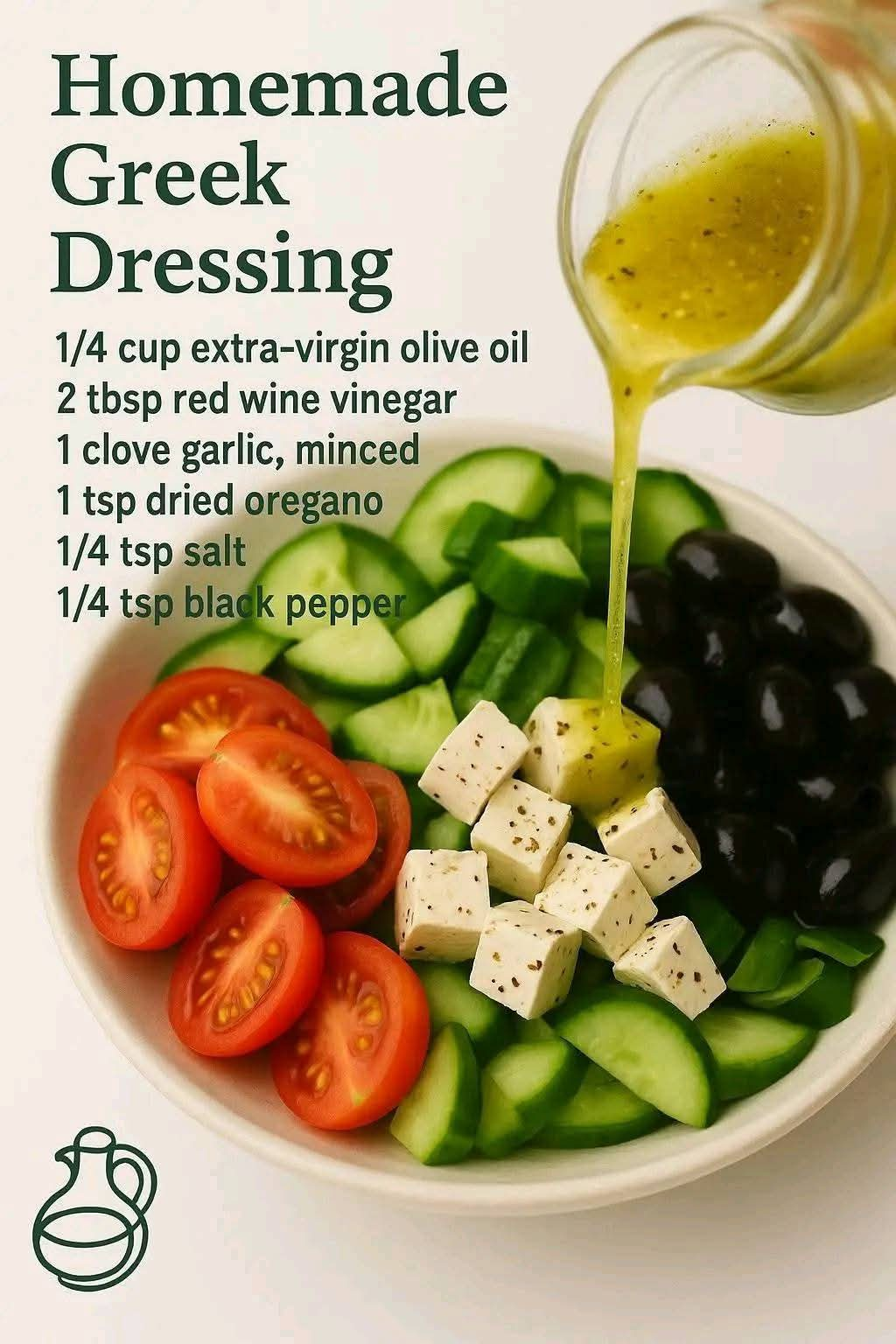Introduction
Greek vinaigrette is a bright, herbaceous dressing that brings Mediterranean flavors to any salad, grain bowl, or roasted vegetables. With its perfect balance of tangy red wine vinegar, rich olive oil, and aromatic oregano, this homemade version is far superior to store-bought alternatives. Not only is it quick and easy to make, but it also allows you to control the quality of ingredients, ensuring a fresh and vibrant taste every time.
This versatile dressing is a staple in Greek cuisine, often used in classic dishes like Greek salad or as a marinade for grilled meats. The addition of garlic and Dijon mustard adds depth, while a touch of lemon juice (if using) brightens the flavors even more. Whether you’re drizzling it over fresh greens or using it as a dipping sauce for warm pita bread, this vinaigrette is sure to become a favorite in your kitchen.
Ingredients
1/2 cup extra virgin olive oil
3 Tbsp red wine vinegar
1 tsp Dijon mustard
1 garlic clove, finely minced or grated
1 tsp dried oregano
1/2 tsp sea salt
1/4 tsp black pepper
(Optional) Juice of 1/2 lemon
Instructions
Add all ingredients to a mason jar or any jar with a tight-fitting lid.
Seal the lid and shake vigorously for about 30 seconds, until the vinaigrette is well emulsified.
Taste and adjust seasoning if needed — add more salt, pepper, or lemon juice.
Use immediately or store in the fridge for up to 10 days.
If the oil solidifies when chilled, let it sit at room temperature for a few minutes, then shake again before using.
Variations
For a creamier texture, try adding a teaspoon of Greek yogurt or mayonnaise to the vinaigrette.
This will give it a slightly thicker consistency, perfect for drizzling over hearty salads or using as a dip.
If you prefer a sweeter note, a teaspoon of honey or maple syrup can balance the acidity beautifully, making it a great pairing for bitter greens like arugula or radicchio.
If you love fresh herbs, swap the dried oregano for a tablespoon of chopped fresh oregano, basil, or parsley. Fresh herbs will lend a brighter, more vibrant flavor to the dressing. For a bolder taste, add a pinch of crushed red pepper flakes or a teaspoon of capers for a briny, tangy kick.
For a citrus-forward version, replace the red wine vinegar with fresh lemon juice or a combination of lemon and orange juice. This variation works especially well with seafood or grain-based salads. Experimenting with different vinegars, such as balsamic or white wine vinegar, can also create unique flavor profiles to suit your preferences.
Tips
Always use high-quality extra virgin olive oil for the best flavor. Since it’s the base of the dressing, a fruity, robust olive oil will make a noticeable difference.
If you’re unsure which vinegar to use, red wine vinegar is classic, but feel free to experiment with apple cider vinegar for a milder taste.
For the freshest garlic flavor, grate the clove rather than mincing it. This ensures it blends seamlessly into the dressing without leaving large chunks.
If you’re sensitive to raw garlic, let the dressing sit for 10-15 minutes before using to mellow the sharpness.
If your vinaigrette separates after sitting, don’t worry—this is natural. Simply give it another good shake before serving.
To help the emulsion stay stable, make sure the Dijon mustard is thoroughly incorporated, as it acts as a natural emulsifier.
How to Store
Store the vinaigrette in an airtight container, such as a mason jar or squeeze bottle, in the refrigerator for up to 10 days.
The olive oil may solidify when chilled, but this doesn’t affect the quality.
Just let it sit at room temperature for a few minutes and shake well before using.
If you plan to use the dressing frequently, consider making a double batch to save time.
Having it ready in the fridge makes it easy to add a burst of flavor to meals throughout the week.
Always check for freshness before using—if the oil smells off or the flavors have dulled, it’s best to discard it.
For longer storage, you can freeze the vinaigrette in an ice cube tray and thaw individual portions as needed.
While the texture may change slightly, the flavor will remain intact, making it a convenient option for meal prep.
Conclusion
Homemade Greek vinaigrette is a simple yet transformative addition to your culinary repertoire. Its bright, zesty flavors elevate even the simplest dishes, turning everyday meals into something special. With just a few pantry staples and a minute of shaking, you can enjoy a dressing that’s healthier, tastier, and more customizable than anything you’d buy at the store.
Whether you stick to the classic recipe or experiment with variations, this vinaigrette is sure to become a kitchen staple. Drizzle it over salads, use it as a marinade, or enjoy it as a dip—the possibilities are endless. Once you taste the difference homemade dressing makes, you’ll never go back to bottled versions again.
